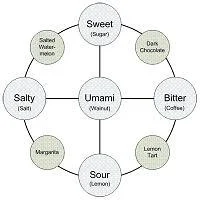Seasonings can be broken down into a few different categories including herbs, spices and condiments. The most popular seasoning known to the world of cooking is salt. Many professional and home cooks misuse salt in everyday applications, not knowing how much to really use. There are so many varieties of salt, each one
 having many unique characteristics and flavor profiles. I can remember my former Exec Chef of GGM telling a story about when he was at CIA: 'Students lined up in front of a pot of butternut squash soup, everyone taking turns tasting a spoonful of the soup. After each of the students tasted, the chef added a teaspoon of salt and they all tasted again. he explained that it was amazing to see the subtle changes in flavor and viscosity (mouth feel) of the soup. The Chef Instructor lined them up and did it again and again, about 6 or 7 times, comparing the finished product to the original unseasoned soup. The addition of salt had changed the soup so immensely, that it almost tasted like a completely different batch.' Although most recipes call for a dash of salt and pepper, it is not always necessary. Learning about the ingredients you choose to cook with will make a big impact on how much seasoning you must add during the cooking process.
having many unique characteristics and flavor profiles. I can remember my former Exec Chef of GGM telling a story about when he was at CIA: 'Students lined up in front of a pot of butternut squash soup, everyone taking turns tasting a spoonful of the soup. After each of the students tasted, the chef added a teaspoon of salt and they all tasted again. he explained that it was amazing to see the subtle changes in flavor and viscosity (mouth feel) of the soup. The Chef Instructor lined them up and did it again and again, about 6 or 7 times, comparing the finished product to the original unseasoned soup. The addition of salt had changed the soup so immensely, that it almost tasted like a completely different batch.' Although most recipes call for a dash of salt and pepper, it is not always necessary. Learning about the ingredients you choose to cook with will make a big impact on how much seasoning you must add during the cooking process.So how do we find the proper balance of seasoning? As we explored in Installment #6 of this series: Umami, The Fifth Flavor, we learned that the tongue has 5 known tastes; sweet, salty, sour, bitter and Umami. True balance is all about the marriage of those tastes on the plate and ultimately on the palate. When cooking with unfamiliar flavors or ingredients, taste them first! Try using classic flavor combinations that our culinary forefathers successfully paired. As I have stated over and over throughout this series, practice makes perfect and as we learn the basics of taste and flavor, our ability to season will be much more successful.
There are many basic guidelines you may follow with regard to using herbs and spices, but remember, there are NO RULES to cooking. Some seasonings are much stronger than others, so begin using small amounts, and then add more as you feel fit. Heartier dishes such as stews and braises can be seasoned well with woody herbs like rosemary or thyme. Lighter dishes like sliced heirloom
 tomatoes and mozzarella cheese may only need a little parsley or basil to bring the palate to absolute harmony.
tomatoes and mozzarella cheese may only need a little parsley or basil to bring the palate to absolute harmony.Other popular seasonings include vinegars, finishing oils (more refined and delicate but full of flavor), soy sauce, wines, spices (such as pepper, cinnamon, clove, nutmeg, saffron and turmeric), and even anchovies, chilies, and garlic. Using herbs can really make a huge difference, so try and find a reputable supermarket for your herb selection, or even better, grow
 your own. Some of my favorites include basil, tarragon, parsley, chives, dill, mint, oregano, lavender, thyme, and rosemary.
your own. Some of my favorites include basil, tarragon, parsley, chives, dill, mint, oregano, lavender, thyme, and rosemary.A great way to incorporate flavors into foods like chicken, steak and seafood, is to combine some spices and or herbs, then add them to an olive oil, creating a marinade. Submerge the protein in the flavorful marinade and let all those seasonings permeate through the food. Be sure to brush most of the marinade off before cooking, as it may burn. Other ways to use spices include making dry rubs, which can enhance flavor, color, and texture. This is an important
 step when preparing BBQ ribs, and without the rub, most ribs may seem lackluster.
step when preparing BBQ ribs, and without the rub, most ribs may seem lackluster.Armed with some knowledge, support and practice, you’ll be making some pretty tasty food in no time! Try some of these ideas out at home, and don’t be disheartened if your first attempts, or two, are unsuccessful. "If at first you don’t succeed, try, try again, don’t give up too easily; persistence pays off in the end."
Other Installments in the At Home Cooking Series:
- 1. Mise en place
- 2. Knife Skills
- 3. Searing & Sauteing
- 4. Mother Sauces
- 5. Grilling Perfect Steak
- 6. Umami, The Fifth Flavor
- 7. Soups & Stocks
- 8. Menu Planning
- 9. Dry Aged vs. Wet Aged Steak
Bon Appetit!
Sources: FreeDigitalPhotos.net


